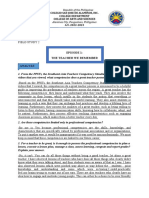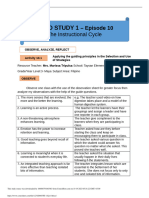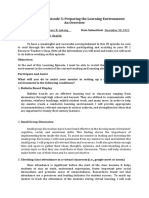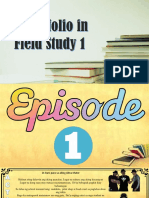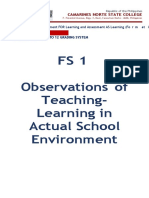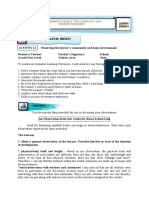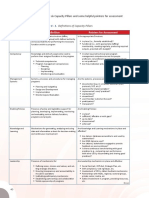Paper For Power Point
Paper For Power Point
Uploaded by
Dhon CaldaCopyright:
Available Formats
Paper For Power Point
Paper For Power Point
Uploaded by
Dhon CaldaOriginal Title
Copyright
Available Formats
Share this document
Did you find this document useful?
Is this content inappropriate?
Copyright:
Available Formats
Paper For Power Point
Paper For Power Point
Uploaded by
Dhon CaldaCopyright:
Available Formats
1. THE STATUS OF MANGYAN EDUCATION IN THE PHILIPPINES Presenters : Anthony Ibarra B. Fabella Don Stepherson V.
Calda Institution : Divine Word College of Calapan (LOGO OF DWCC) Calapan City, Oriental Mindoro Philippines
2. 3. Mindoro is the seventh largest Island in the Philippines, with two Provinces, Oriental and Occidental, with a total population of one million. The Mangyan population is estimated at 10% of the total population or 100,000 Mangyans. It has an area of 10,224 square kilometers. (map of Philippines and Mindoro) 4. Mangyan is the generic name for the indigenous groups found in Mindoro Island, each with its own tribal name, language, and set of customs. There are eight (8) tribes that exist in the province namely Alangan, Bangon, Tau-Buhid, Buhid, Hanunuo, Tadyawan, Iraya and Ratagnon. Each tribe is living with different traditions, ethnic laws and way of life. (picture of Mangyans) 5. In 1989, through the help of Mr. Benjamin Abadiano with the Paitan Mangyan Mission (PMM), a mangyan school was founded in the foot of the mountains of Barangay Paitan, Naujan, Oriental Mindoro, Philippines which serves the eight tribes of Mangyans in Oriental Mindoro. Using a curriculum relevant to the needs and culture of the Mangyans, they call it as Tugdaan Mangyan Center for Learning and Development. (logo of Tugdaan) 6. According to the school's manual, "Tugdaan" is an Alangan Mangyan term for "seedbed" to stress the "program's commitment to root the development of the Mangyan in the realities of their culture, needs and aspirations in life." 7. The threefold objectives of the whole educational program are as follows: 1) To assist the Mangyans alleviate their social, political, economic and cultural conditions; 2) To guide them to assert their rights of self-determination and self-governance and; 3) To facilitate their growth towards an integrated human development. 8. In 1992, Tugdaan received recognition from the Department of Education totally operate as a formal secondary education program for the Mangyan communities through Deped Recognition # 029 series of 2002. Four years later, Tugdaan was most recognized as the Most Outstanding Literacy Program in the Philippines by the Department of Education.
9. This research is anchored on the social learning theory of Gabriel Tarde. He conceives that education is based on small psychological interactions among individuals and that the fundamental forces were imitation and innovation. For him, social learning focuses on the learning that occurs within a social context.
10. The Tugdaan Mangyan Center for Learning and Development is using the eight (8) elements of Indigenous Peoples Education System. These elements serve as the framework on how the IP education system is structured, to wit: 1. Valuing Education 2. Promoting cultural integrity and empowerment 3. Promoting peoples involvement and participation 4. Enhancing analytical thinking and responsible attitudes 5. Promoting peace and community building 6. Valuing land and environment 7. Promoting the spirit of service and volunteerism 8. Promoting holistic and integrative learning
9. (core picture)
10. From 1992-2008, Tugdaan School was able to cater 1,428 students. The statistical data is shown below. (please make a graph) SCHOOL YEAR 1995-1996 1996-1997 1997-1998 1998-1999 1999-2000 2000-2001 2001-2002 2002-2003 2003-2004 2004-2005 2005-2006 2006-2007 ENROLLMENT COUNT ENROLLEES
FEMALE MALE TOTAL
19 27 30 35 39 58 51 53 73 111 90 92
38 41 58 64 55 72 77 70 86 84 71 79
42 50 74 89 88 110 99 112 138 179 134 171
2007-2008
86
75 TOTAL
142 1,428
11. Figure 3 Enrollment count of Tugdaan Mangyan Center for Learning and Development
12. ( graph also) SCHOOL YEAR 1995-1996 1996-1997 1997-1998 1998-1999 1999-2000 2000-2001 2001-2002 2002-2003 2003-2004 2004-2005 2005-2006 2006-2007 2007-2008 2008-2009 TOTAL 13. (graph also) COURSES TAKEN BY TUGDAAN GRADUATES Bachelor in Elementary Education Bachelor of Science in Agriculture Bachelor in Secondary Education Religious education (Catechist) Bachelor of Arts Electrician Automotive Bachelor of Agricultural Technology Marine Engineering Electronics Drafting Commerce Social Work HTO Computer Secretarial Midwifery` Diploma in Agricultural Technology Seminary NO. OF GRADUATES 28 16 13 13 9 5 5 3 3 3 3 2 2 2 1 1 1 1 NO. OF GRADUATES 9 7 10 14 19 24 20 18 23 28 36 40 31 25 305
Figure 4 Graduates of Tugdaan Mangyan Center for Learning and Development
Food Technology Nursing Aid Nurse Caregiver Computer Science
Figure 5 College Courses taken by Tugdaan Graduates
1 1 1 1 1
14. DIFFERENT PROGRAMS UNDER THE TUGDAAN MANGYAN CENTER FOR LEARNING AND DEVELOPMENT
15. Bisloy Le is an outreach program of Tugdaan for Mangyan children in various communities outside of Paitan, Naujan, Oriental Mindoro. The program creates venues for students to discover their talents and skills, while at the same time strengthen their appreciation of their culture.
16. The Research Center for Mangyan Culture is recognized as the heart of all the activities and programs of Tugdaan. Its purpose is to nourish the culture of the Mangyans and at the same time, share it with others. Activities in the center include research and writing down of history, beliefs, rituals, folktales, sayings and songs of the Mangyans.
17. Community Development Programs has paved the way in forming the youth, parents and elders of the community in the best of their potentials and skills with regards to social responsibility and governance. The vision, mission and goals of the community are considered to be the guide in forming the future of the Mangyan communities.
18. The main purpose of Environment and Resource Management program is to enhance and strengthen the capabilities of the Mangyans in the preservation and conservation of the environment. This program serves as a way for the youth to learn and discover the different ways and methods of farming without harming the nature.
19. Sustainability Programs include food preservation and processing of quality products such as virgin coconut oil, fruit jams, wild honey and different kinds of tea. These activities serve as resource generation to sustain the programs and projects of the school. 20. RECOMMENDATIONS / POINTS FOR ACTION
21. Replicating the program of Tugdaan Mangyan Center for Learning and Development in different areas where the indigenous communities are present.
22. Participation of different local and international organizations to sustain the different programs supporting and preserving the culture, custom and education of the indigenous peoples.
23. Intervention of first-world countries in helping the Mangyans to sustain their educational programs thru scholarship, exchange students, volunteers and the like.
24. Further study/discussions may be replicated in other indigenous peoples communities.
You might also like
- My Dinner With AndreDocument18 pagesMy Dinner With Andremaison_orion100% (1)
- Federal Complaint Against Barrett Daffin Frappier Treder and Weiss For Legal MalpracticeDocument9 pagesFederal Complaint Against Barrett Daffin Frappier Treder and Weiss For Legal Malpracticekevin100% (2)
- Tugdann Indigenous High SchoolDocument2 pagesTugdann Indigenous High SchoolEllarosejann Marlowe PagueNo ratings yet
- Episode 5 FS 1Document5 pagesEpisode 5 FS 1FloralinGumop-asNo ratings yet
- FS2 EPISODE 5: Preparing The Learning Environment: An OverviewDocument5 pagesFS2 EPISODE 5: Preparing The Learning Environment: An OverviewDelos Santos Gleycelyn L.100% (1)
- Fs1 Episode 4 FinalDocument8 pagesFs1 Episode 4 FinalJenny Pusa PizonNo ratings yet
- Episode 3Document21 pagesEpisode 3Edlyn Mae CastroNo ratings yet
- FS2 Episode 2Document7 pagesFS2 Episode 2Aire NaldoNo ratings yet
- Field Study 1 (Episode 4)Document5 pagesField Study 1 (Episode 4)Seanie ReyesNo ratings yet
- Field Study 1 - Episode 1Document12 pagesField Study 1 - Episode 1Christine100% (1)
- FS2 Complete Learning EpisodesDocument81 pagesFS2 Complete Learning EpisodesNiña Gel Gomez AparecioNo ratings yet
- FS2 Episode 1 by JessieDocument5 pagesFS2 Episode 1 by JessieJessie PeraltaNo ratings yet
- FS 1 Ep 10Document8 pagesFS 1 Ep 10RylNo ratings yet
- FS 2 - Learning Epsisode 1 - Activity 1Document9 pagesFS 2 - Learning Epsisode 1 - Activity 1DANIELA GALINGANNo ratings yet
- FS2 Ep1Document18 pagesFS2 Ep1Shiella May PanteNo ratings yet
- FS 1 - Episode 1Document12 pagesFS 1 - Episode 1Angelica LlamasNo ratings yet
- Examples of Formative AssessmentDocument4 pagesExamples of Formative AssessmentAnonymous yIlaBBQQNo ratings yet
- FS 1 EPISODE 4 - Learner Diversity, The Community and Home EnvironmentDocument6 pagesFS 1 EPISODE 4 - Learner Diversity, The Community and Home EnvironmentZenaida SingsonNo ratings yet
- Episode 5 - To PrintDocument7 pagesEpisode 5 - To PrintRosary LubongNo ratings yet
- MOTHER TERESA and MAHATMA GANDHIDocument2 pagesMOTHER TERESA and MAHATMA GANDHIARABELLA FUNDARNo ratings yet
- fs1 Episode 6Document6 pagesfs1 Episode 6Jamille Nympha C. BalasiNo ratings yet
- LE5-Understanding AR Concepts, Process and ModelDocument27 pagesLE5-Understanding AR Concepts, Process and ModelCristal Castro100% (2)
- FS 2 Episode 5Document11 pagesFS 2 Episode 5Maridel B. BabagayNo ratings yet
- Learning Episode 16 On Teachers Philosophy of EducationDocument8 pagesLearning Episode 16 On Teachers Philosophy of EducationKaren Marie Dela PasionNo ratings yet
- FS 2 Narrative Report-Group 4Document5 pagesFS 2 Narrative Report-Group 4Bryan JunioNo ratings yet
- ED 113 Chapter 2Document9 pagesED 113 Chapter 2Nerry Jade RamosNo ratings yet
- Learning Episode 3 (FS2)Document5 pagesLearning Episode 3 (FS2)Tobio KageyamaNo ratings yet
- FS1 Ep16Document7 pagesFS1 Ep16Jervyn GuiananNo ratings yet
- Episode 8Document11 pagesEpisode 8annieguillermaNo ratings yet
- FS 1 Episode 13Document7 pagesFS 1 Episode 13Jerald CarletNo ratings yet
- Field Study 2 Episode 6Document7 pagesField Study 2 Episode 6Gina May Punzalan PanalanginNo ratings yet
- This Study Resource Was: AnalyzeDocument5 pagesThis Study Resource Was: AnalyzeVia Mae VirtousaNo ratings yet
- Field Study 2 Learning Episode 1...Document27 pagesField Study 2 Learning Episode 1...Ryan Joseph Delos SantosNo ratings yet
- E Portfolio in FS1Document156 pagesE Portfolio in FS1GlenMalupetNo ratings yet
- FIELD STUDY-1 (Episode 4)Document11 pagesFIELD STUDY-1 (Episode 4)Lady Lyn Tilles HugnoNo ratings yet
- Reflections On The Field Study Area ObserveDocument1 pageReflections On The Field Study Area ObserveJames BracamonteNo ratings yet
- Episode 7Document6 pagesEpisode 7Reyna Gen RiveraNo ratings yet
- Field Study 1 Answers - Episode 6 PDFDocument11 pagesField Study 1 Answers - Episode 6 PDFJerra BallesterosNo ratings yet
- FS 401. Episode 2Document9 pagesFS 401. Episode 2Danica Joy Aguilon BesaNo ratings yet
- Chapter 1 ASEAN and English (Week 1) : Activity 1: Reflective EssayDocument5 pagesChapter 1 ASEAN and English (Week 1) : Activity 1: Reflective EssayJay Ann Candelaria OlivaNo ratings yet
- Action Research PaperDocument37 pagesAction Research PaperKATE SHELOU TABIANNo ratings yet
- Listing Down Classroom Rules: Observing Classroom Management RoutinesDocument5 pagesListing Down Classroom Rules: Observing Classroom Management RoutinesMariya QuedzNo ratings yet
- FS 1-Episode 1Document9 pagesFS 1-Episode 1Vincent Jake NaputoNo ratings yet
- FIELD STUDY Ep.1 4Document79 pagesFIELD STUDY Ep.1 4And'z MirabuenoNo ratings yet
- FS1 Ep3Document6 pagesFS1 Ep3Bane LazoNo ratings yet
- Action Research Full BlownDocument15 pagesAction Research Full BlownAngustia MaslogNo ratings yet
- EPISODE 1 and 2Document50 pagesEPISODE 1 and 2Jerome SabejonNo ratings yet
- Field Study 1 Learning Episode 9Document15 pagesField Study 1 Learning Episode 9Joshua Lander Soquita Cadayona100% (1)
- LAS 10 The Instructional CycleDocument5 pagesLAS 10 The Instructional CycleHiezel G LandichoNo ratings yet
- Source Ep 12Document17 pagesSource Ep 12Jan Paulyne CastillejosNo ratings yet
- FS 1 Learning Episode 3 Activity 3.1 To 3.3 Observing Learner Characteristics at Different StagesDocument13 pagesFS 1 Learning Episode 3 Activity 3.1 To 3.3 Observing Learner Characteristics at Different StagesCharles Martine Dizon TriaNo ratings yet
- Episode 16Document7 pagesEpisode 16Gene Lloyd Nacor100% (1)
- Fs1 Sample Episode 1Document8 pagesFs1 Sample Episode 1Francesnova B. Dela PeñaNo ratings yet
- FS1-EP-9 Cont..Document11 pagesFS1-EP-9 Cont..Alyzza Javier Vidad IINo ratings yet
- Episode 11 16Document33 pagesEpisode 11 16mark san andresNo ratings yet
- NACINOPA - FS 1 Learning Episode 4Document10 pagesNACINOPA - FS 1 Learning Episode 4Rolando Nacinopa Jr.No ratings yet
- FS 2 - Episode 13-15Document20 pagesFS 2 - Episode 13-15Esther Italia LoridaNo ratings yet
- Learning Episode 5: Creating An Appropriate Learning EnvironmentDocument13 pagesLearning Episode 5: Creating An Appropriate Learning EnvironmentMarwin Rebollos ApolinarioNo ratings yet
- fs1 Ep12 UpdatedDocument9 pagesfs1 Ep12 UpdatedMillet CastilloNo ratings yet
- Fs3episode2a 161230010629Document11 pagesFs3episode2a 161230010629Khen PamaNo ratings yet
- Sanchez, Niño Mike Angelo M. Part 1, Part 2, Part 3 and Related AppendicesDocument52 pagesSanchez, Niño Mike Angelo M. Part 1, Part 2, Part 3 and Related AppendicesNinoMikeAngeloS100% (2)
- FS1 Ch6Document23 pagesFS1 Ch6mia rolane jagoniaNo ratings yet
- List of Resource SpeakersDocument101 pagesList of Resource SpeakersDhon CaldaNo ratings yet
- Lecture 1 Introduction To DiplomacyDocument35 pagesLecture 1 Introduction To DiplomacyDhon CaldaNo ratings yet
- MIMAROPA 2022 Statistics InventoryDocument5 pagesMIMAROPA 2022 Statistics InventoryDhon Calda100% (1)
- 048 Memo On The Proposed Unbundling and Re Assignment of Devolved Functions and ServicesDocument5 pages048 Memo On The Proposed Unbundling and Re Assignment of Devolved Functions and ServicesDhon CaldaNo ratings yet
- Oil Spill Recovery Plan TemplateDocument2 pagesOil Spill Recovery Plan TemplateDhon CaldaNo ratings yet
- Training Design - Research ColloquiumDocument8 pagesTraining Design - Research ColloquiumDhon CaldaNo ratings yet
- State of Calamity ResolutionDocument2 pagesState of Calamity ResolutionDhon CaldaNo ratings yet
- 2018 FinalManual of Operations PTIEDO PHRMO May 2018Document22 pages2018 FinalManual of Operations PTIEDO PHRMO May 2018Dhon CaldaNo ratings yet
- Cultural Research Colloquium: 24-25 March 2022 - Mangyan Ballroom Hall, Oriental Mindoro Heritage MuseumDocument1 pageCultural Research Colloquium: 24-25 March 2022 - Mangyan Ballroom Hall, Oriental Mindoro Heritage MuseumDhon CaldaNo ratings yet
- The National Commission For Culture and The ArtsDocument7 pagesThe National Commission For Culture and The ArtsDhon CaldaNo ratings yet
- Letter DWCC Tour PackagingDocument1 pageLetter DWCC Tour PackagingDhon CaldaNo ratings yet
- LGU Capacity Assessment and CADEV Agenda Formulation Toolkit 48Document1 pageLGU Capacity Assessment and CADEV Agenda Formulation Toolkit 48Dhon CaldaNo ratings yet
- The Sangguniang PanlalawiganDocument19 pagesThe Sangguniang PanlalawiganDhon CaldaNo ratings yet
- Inventory of Ppas: 2021-2022 Concerned OfficeDocument1 pageInventory of Ppas: 2021-2022 Concerned OfficeDhon CaldaNo ratings yet
- Communications Plan TemplateDocument1 pageCommunications Plan TemplateDhon CaldaNo ratings yet
- Capacity Development Agenda: 2022-2024 Provincial Government of Oriental MindoroDocument3 pagesCapacity Development Agenda: 2022-2024 Provincial Government of Oriental MindoroDhon Calda88% (8)
- MinOr - Tourism Circuit Devt Workshop On Sept 23Document3 pagesMinOr - Tourism Circuit Devt Workshop On Sept 23Dhon CaldaNo ratings yet
- Lecture On Arnold JanssenDocument27 pagesLecture On Arnold JanssenDhon CaldaNo ratings yet
- MC No. 2021-003 - Establishment of The Professional Tour Guides Qualification Examination (PTGQUALEX)Document8 pagesMC No. 2021-003 - Establishment of The Professional Tour Guides Qualification Examination (PTGQUALEX)Dhon CaldaNo ratings yet
- Letter - NCCA - Mangyan CenterDocument1 pageLetter - NCCA - Mangyan CenterDhon CaldaNo ratings yet
- Philosophy of Values - Lecture Notes 1Document1 pagePhilosophy of Values - Lecture Notes 1Dhon CaldaNo ratings yet
- Faculty Development 2Document28 pagesFaculty Development 2Dhon Calda100% (2)
- Statement of Purpose - Coffee Table BookDocument2 pagesStatement of Purpose - Coffee Table BookDhon CaldaNo ratings yet
- Gawad Balay Lakoy 2018Document6 pagesGawad Balay Lakoy 2018Dhon CaldaNo ratings yet
- Lecture On Arnold JanssenDocument40 pagesLecture On Arnold JanssenDhon CaldaNo ratings yet
- Yamuna River-2Document2 pagesYamuna River-2Munnur PandariNo ratings yet
- UPCAT Physics Review Part 2Document37 pagesUPCAT Physics Review Part 2Clarise VicenteNo ratings yet
- nts330 W15finalproject StardotstarDocument21 pagesnts330 W15finalproject Stardotstarapi-374835421No ratings yet
- Logo-Design-Guide Part 1Document5 pagesLogo-Design-Guide Part 1Marija VeljkovicNo ratings yet
- Angeles University Foundation: September 2008 New Acquisitions ListDocument7 pagesAngeles University Foundation: September 2008 New Acquisitions Listauflibrary1341100% (1)
- Journal Pipeline Engineering 2013Document76 pagesJournal Pipeline Engineering 2013JAbidMukarrom100% (1)
- Accomplishment Report Grade ChairpersonDocument14 pagesAccomplishment Report Grade ChairpersonKathleen Kay SubaldoNo ratings yet
- Physiology Directory PDFDocument3 pagesPhysiology Directory PDFGreen land school KollapurNo ratings yet
- Is So Called Phenomenal Intentionality Real Intentionality?: Elisabetta SacchiDocument24 pagesIs So Called Phenomenal Intentionality Real Intentionality?: Elisabetta SacchiArifa'iNo ratings yet
- Money TalksDocument138 pagesMoney TalksFernanda RabacaNo ratings yet
- 2015 Module 2 PPT 1Document65 pages2015 Module 2 PPT 1Tengku Ahmad HakimiNo ratings yet
- Modal VerbsDocument1 pageModal VerbsJuana Valentina Londoño BritoNo ratings yet
- Unit One: Development of Capitalism in Europe and U.S.A The Second Industrial RevolutionDocument38 pagesUnit One: Development of Capitalism in Europe and U.S.A The Second Industrial RevolutionHafsa musa hafuNo ratings yet
- Philippine Lawyer's Association v. Agrava, G.R. No. L-12426Document2 pagesPhilippine Lawyer's Association v. Agrava, G.R. No. L-12426AllysaJoyDadullaNo ratings yet
- MasturbationDocument19 pagesMasturbationLA Laguit100% (1)
- Expressing Opinion 0Document35 pagesExpressing Opinion 0Ali ChahinNo ratings yet
- Assignement 1: Exercise 1Document2 pagesAssignement 1: Exercise 1Arbi Chaima100% (1)
- C++ Syntax and Semantics, and The Program Development ProcessDocument20 pagesC++ Syntax and Semantics, and The Program Development Processnachan123No ratings yet
- British Literature - WikipediaDocument219 pagesBritish Literature - Wikipediahamedbaikoro34No ratings yet
- Coding File InventoryDocument10 pagesCoding File InventoryNovia HylsandyNo ratings yet
- Clientele & Audiences in Social WorkDocument6 pagesClientele & Audiences in Social WorkIssaVillanuevaNo ratings yet
- Zno WritingDocument40 pagesZno WritingНаталія Галамага100% (2)
- Subscripts Concluded and Word OrderDocument2 pagesSubscripts Concluded and Word OrderPolisettyNo ratings yet
- The Call of The WildDocument2 pagesThe Call of The Wildarinavardanyan13No ratings yet
- Ra 8491 Flag and Heraldic Code of The PhilippinesDocument15 pagesRa 8491 Flag and Heraldic Code of The PhilippinesLeon Odarniem Saniraf EtelpNo ratings yet
- 9th Class Maths PDFDocument20 pages9th Class Maths PDFsrinivasbudati100% (2)
- Digest in MalversationDocument6 pagesDigest in Malversationver legaspiNo ratings yet
- Manual-FanTestic Integrity (NFPA)Document22 pagesManual-FanTestic Integrity (NFPA)Salley BukhariNo ratings yet











